How to Visit the Vatican (Museums + St. Peter’s Basilica)
The combination of the Vatican Museums and St. Peter’s Basilica is quite possibly the most impressive collection of art in the world (the Louvre is the only collection I can think of that comes close in breadth and impressiveness).
Now, I’m not saying it’s my favorite collection of art – I generally prefer museums that tell a cohesive story like the Rodin Museum in Paris – but the sheer amount of art and its breadth (one of my favorite parts of the collection is the hall of maps) is truly staggering.
The Catholic Church has played an integral role in the story of politics in Europe for almost two millennia, and the Vatican is the culmination of centuries of exerting power and influence over the rest of the continent.
Think about the wealth and power that it takes to accumulate or commission all of this fantastic (and expensive) artwork and architecture from some of the most famous artists in Italian (really, world) art history.
One contradiction that always pops up in the back of my mind when visiting huge, ornate churches has to do with the role of the church.
Why, you might ask, does an organization that preaches the Bible, which unequivocally condemns rich people who do not give away their wealth, have such an ornate and over-the-top display of wealth?
Great question to ask the Pope, if you run into him (or her, in case you’re reading this at a time when we’ve gotten a female pope).
As a religious site, I have questions about the Vatican and St. Peter’s Basilica.
If you put those questions aside for a second and just consider them as a collection of art, it’s a pretty incredible display featuring a who’s who of Italian art history.
I, Matt, have now been to the Vatican Museums and St. Peter’s Basilica four times each, including two times in the past two years. I’ve done them both independently and as part of a guided tour (two and two), which gives me the perspective and experience to make recommendations on how to make the most of your time (and money).
In this guide, we’re going to use our experience to give you everything you need to know to visit the Vatican for the first time.
In the (long) guide below, we’re going to go through the different pieces of the Vatican (the Vatican Museums and St. Peter’s Basilica), what to prioritize (you won’t be able to see it all!), and how to get tickets, and what to expect when you’re there.
By the end of the guide, you’ll have all the information you need to plan your own visit (and get tickets to the Vatican Museums, which do sell out).
Sound good to you? Let’s get into it.
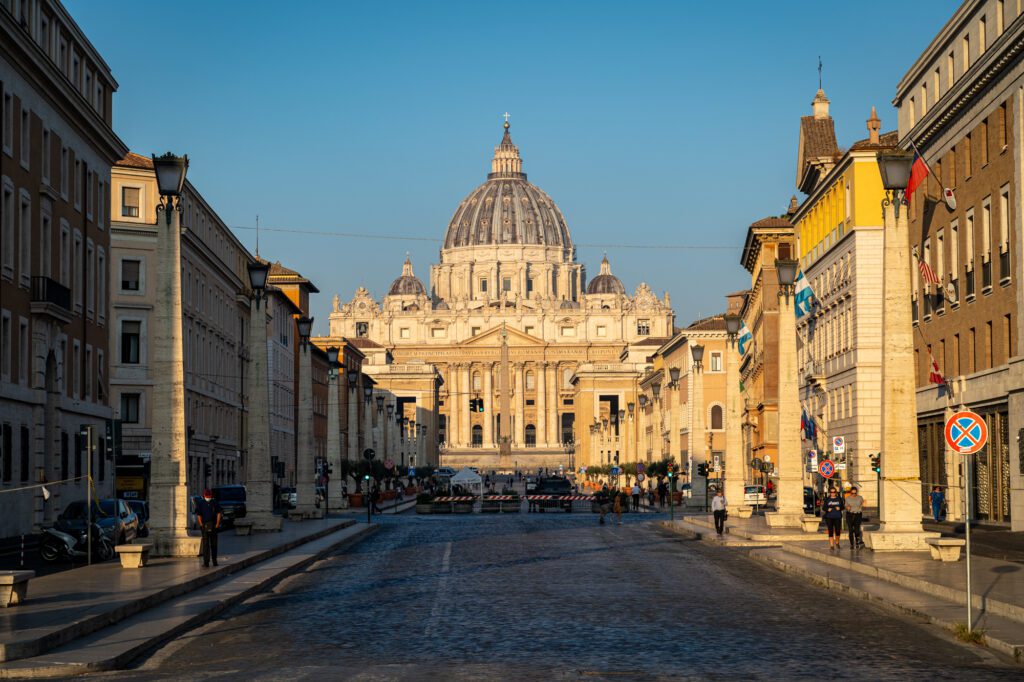
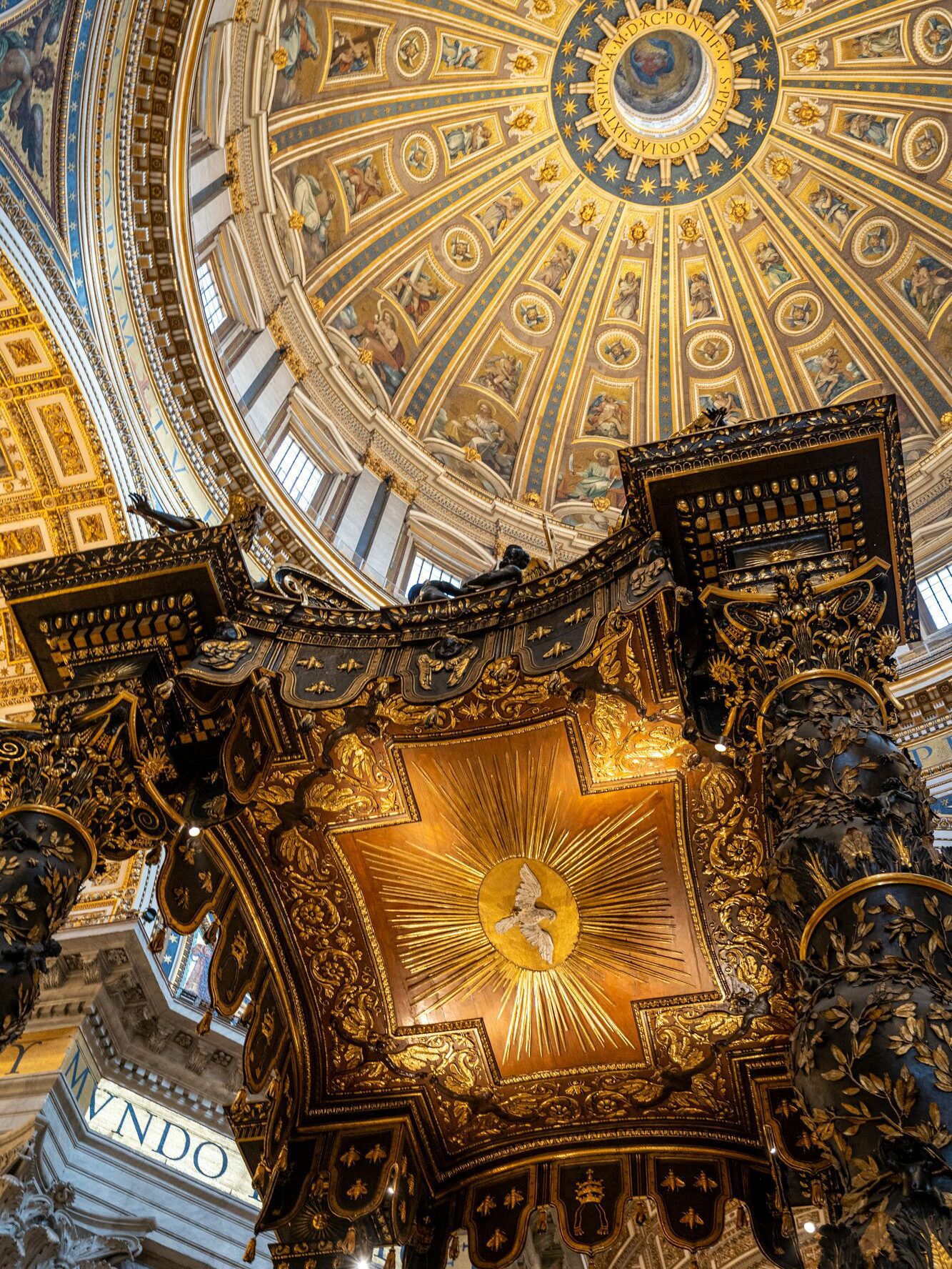
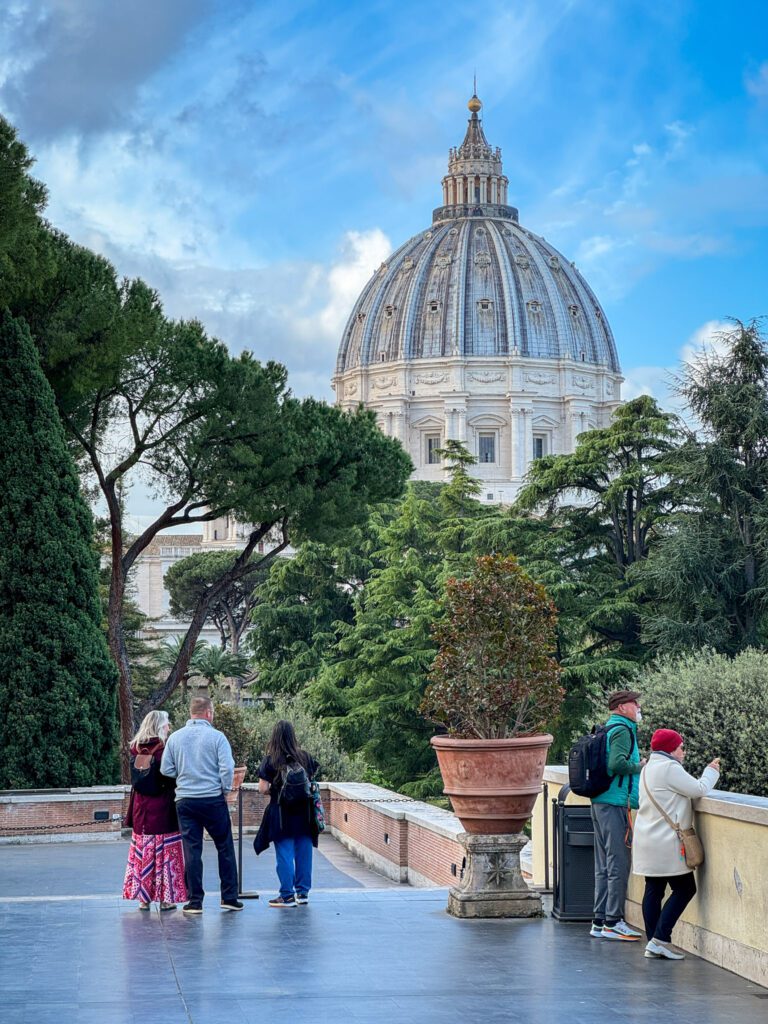
Disclaimer: Some of the links in this post, like hotel links, are affiliate links, meaning at no additional cost to you, we make a little bit of money if you click through and book. That being said, we would never recommend something to you that we don’t stand behind 100%.
What, Exactly, is the Vatican?
The existence of the Vatican – the full name is the Vatican City State – is a relic of one of my absolute favorite topics to read and talk about recently: the unification of Italy.
If you’ve read any of our other Italy guides (like our 10 day Italy itinerary), you’ll probably have seen me say something to the effect of “Italy is actually one of the youngest countries in western Europe.”
Which is counterintuitive, especially when you’re thinking about Rome, which was THE global superpower (in the context of Europe, North Africa, and the Mediterranean at least) for centuries about 2,000 years ago.
But the unification of Italy took place somewhere between 1860 and 1870, depending on which exact event you’re using as the cutoff.
This is relevant here because the final step in the unification of Italy was the capture of Rome by the newly formed Kingdom of Italy in 1870.
Who did they seize Italy from, you ask? The Papal States, which were one of the preeminent powers on the Italian Peninsula for 1,000 years and were under the rule of the Pope.
Most of the territory that they controlled was incorporated into the Kingdom of Italy (which is the first iteration of modern Italy as we know it) except for one small slice – the area around St. Peter’s Basilica and the offices and residences associated with the Pope.
That slice was in an ambiguous situation for decades in a kind of standoff, where Rome didn’t want to anger the Catholic Church and the Pope, but also wasn’t willing to completely cede control of the territory (though they did limit the secular power of the Pope which wasn’t, uh, well received by the church).
That situation continued until 1929, when a certain (in)famous Italian autocrat interested in restoring the golden age of Italy signed a treaty that cemented the independent status of the Vatican.
And that, my friends, is how the Vatican came to be an independent state within the city of Rome.
What Can You See at the Vatican?
For your purposes as a visitor, there are really two pieces of the Vatican that you should care about: The Vatican Museums and St. Peter’s Basilica.
Plus Piazza San Pietro, the huge piazza outside the front doors of the basilica where the papal audience takes place.
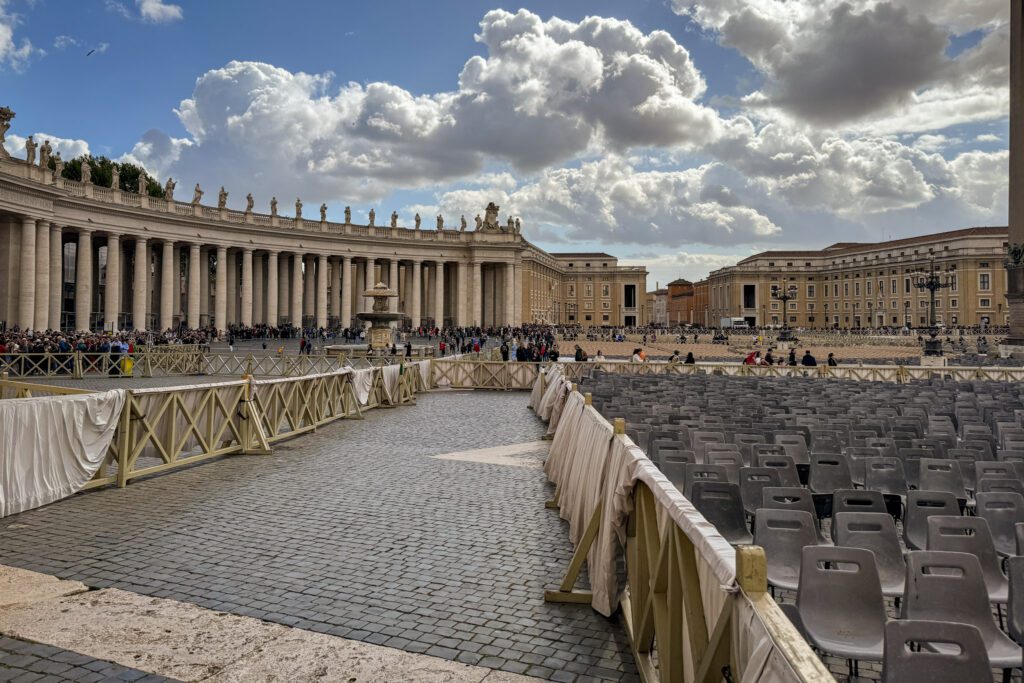
The first thing we want to make super clear is that the Sistine Chapel is a part of the Vatican Museums, and the way to visit it is to get tickets for the Vatican Museums (more on that below, obviously).
We’re going to cover the two pieces of the Vatican in separate sections below, because each of them has a separate protocol for visiting.
However, it’s worth noting that there are some practical implications to the fact that there are separate entry protocols for the two main sights here.
The main implication is that I would consider doing the Vatican Museums and St. Peter’s Basilica on different days if you have the time in your itinerary.
The reason is that, by the time you’re done with the Vatican Museums and Sistine Chapel, it will be around noon (maybe even later, depending on your pace).
Which means you’re going to be waiting in the security line that often wraps around the entirety of the piazza.
I would recommend, if you have the time, getting to St. Peter’s Basilica at opening (currently 7:00am at the time of writing) on a different day for a much more relaxing experience, and for the fact that the light will be better if you choose to climb the Dome (plus fewer people in the narrow passageways).
That’s exactly what I did with my mom and uncle on my latest trip (Vatican Museums at 8:00am one day, St. Peter’s Basilica at 7:00am another day, and it worked great).
The Vatican Museums (Including the Sistine Chapel)
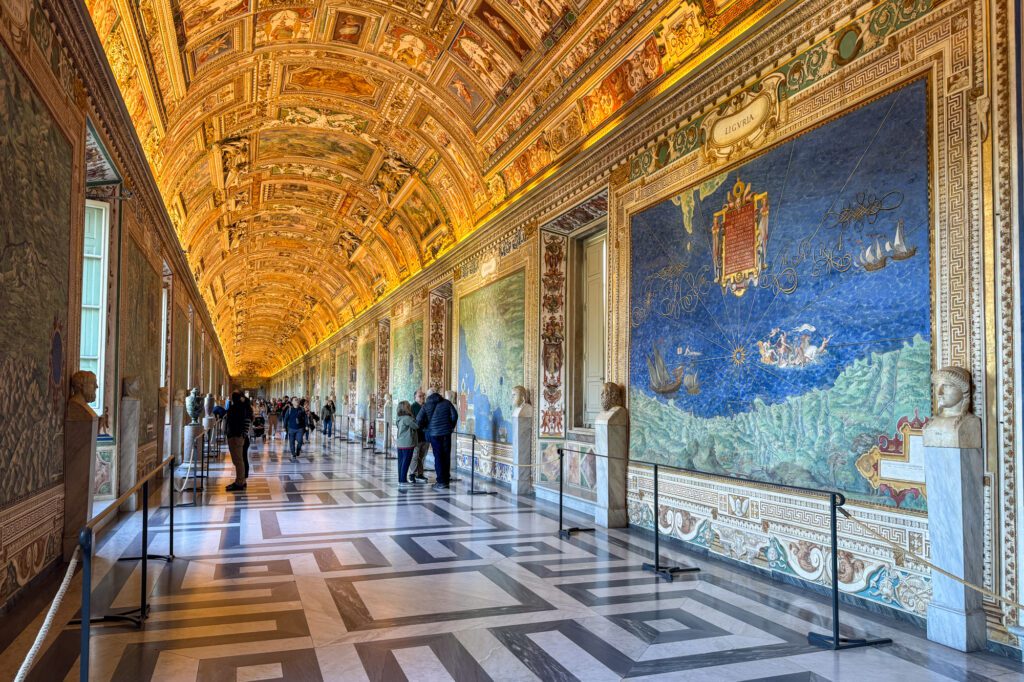
The Vatican Museums are arguably the most famous collection or art in the world.
It’s a sprawling collection that spans everything from Roman statues made of marble, to ornate tombs for Roman emperors, to the finest tapestries and paintings from Italian masters.
The Vatican Museums contain a whopping 20,000 pieces of art and culminate with the legendary Sistine Chapel, where the ceiling frescos bear the famous work of Michelangelo.
I’ve seen it four times now, and each time I am completely spellbound by the storytelling and detail that has gone into every single aspect of the Sistine Chapel, particularly the Last Judgement that covers the wall above the altar.
And, yes, the first thing you need to know here is that the Sistine Chapel is inside the Vatican Museums, and is covered by the same entry ticket.
It’s also worth noting that it is the last thing you’ll see, saving the best for last, because of the way the museum is laid out.
You’ll go through the entire collection before ending at the Sistine Chapel, and we think this is a good way to organize your visit (though it does mean it will be relatively crowded in the Chapel when you arrive there).
Some people like to make a beeline for the Sistine Chapel so that they’re first inside, but this means you’ll be doing a lot of “hurry up and wait” – the Sistine Chapel doesn’t open at the same time as the broader complex (and it’s kind of murky when exactly it does open), so you’ll likely run to the entrance and then stand there.
Instead, we prefer having fewer crowds in the museums before you arrive at the Chapel because in the Chapel everyone is looking up, and thus there is nobody blocking your view (unlike if you’re trying to see a sculpture and read the information on the panel next to it).
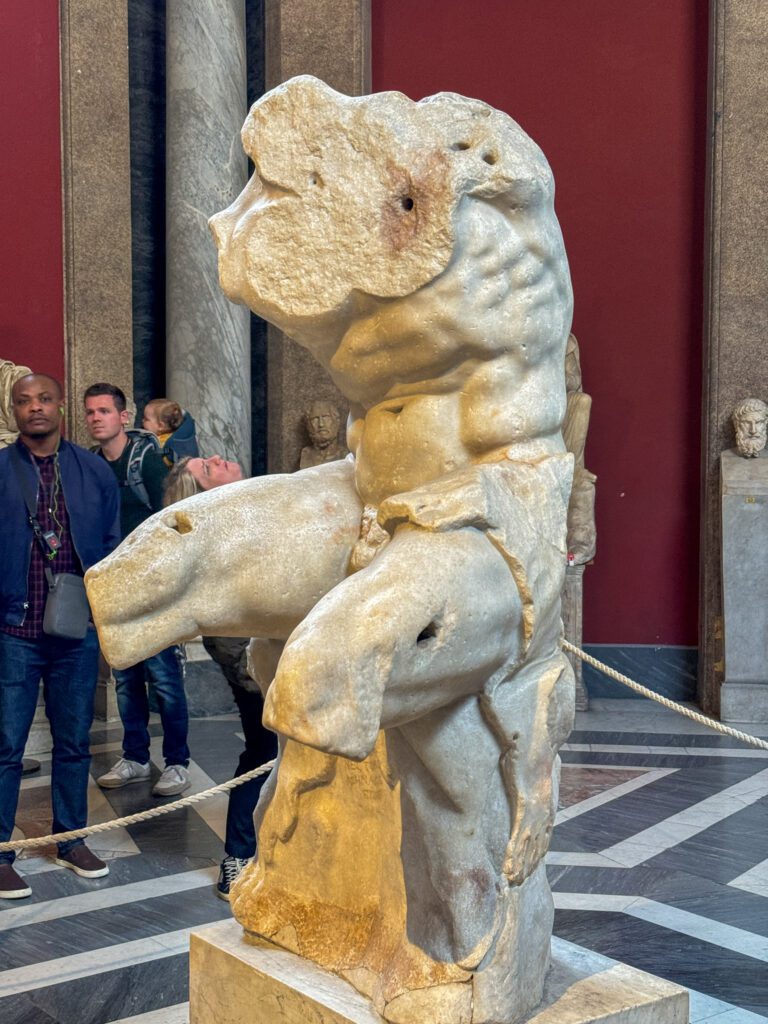
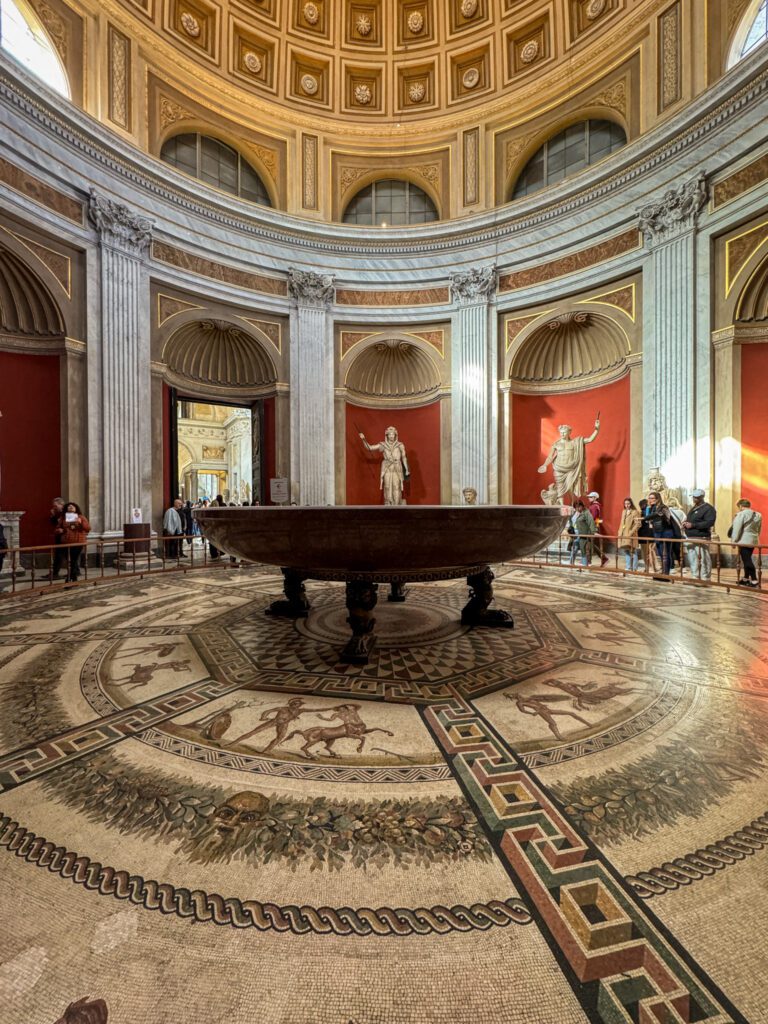
Should You Do a Tour of the Vatican Museums?
One of the most important lessons we’ve learned over the past few years of traveling is to always opt for a guided tour when it comes to big art museums with sprawling collections, which certainly includes the Vatican Museums.
We’d definitely recommend a guided tour here to help you make sense of the huge art collection, but we think it’s less of a necessity than it is with the Colosseum and Forum, which really require a guide to fully enjoy and understand.
We’re not huge art buffs, and we have often had the experience of walking into a museum, wandering around for a bit, reading some signs, and walking out having learned almost nothing and wondering if we were the problem.
After a perspective-changing tour of the Uffizi Gallery in Florence a few years ago, we realized that we can be art people, we just need the added context and story behind the art to help us understand what exactly we’re looking at.
Now, we generally opt to visit one museum per city, and we go deep with a guided tour to get the most out of our visit.
The guide will give you all of the context and history you need to actually understand what you’re looking at, and will help you figure out what to see and what to skip in order to help tell that story.
On my trip to Rome last spring, I decided to splurge and do the “Pristine Sistine” tour with my favorite tour company in Italy, Walks of Italy (this was my fifth tour with them, not including the other tours I’ve done outside of Italy with their broader company, Walks).
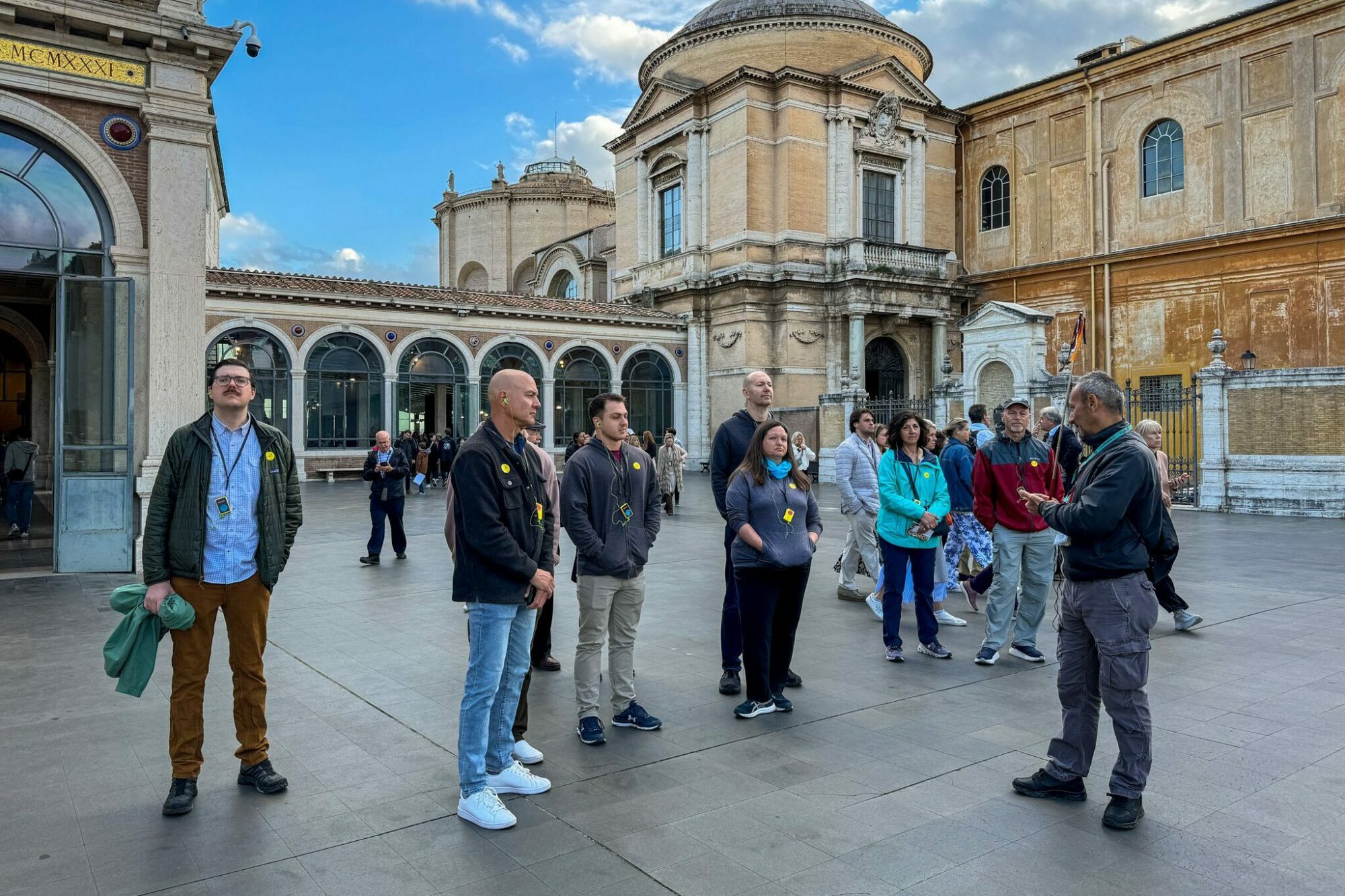
Walks of Italy’s expert guides are among the best in the business, at least in my experience.
The worst Walks guide I’ve had was bang-on average in the grand scheme of guided tours I’ve taken in my lifetime, which is a pretty good batting average across 5-6 different tours.
Several – namely Dario from our memorable Colosseum Tour – are among the best guides we’ve ever had the privilege of doing a tour with.
It was a great tour, though it’s important to know that there is no scenario where you’re going to be in the Sistine Chapel without crowds, on a tour or not.
If you do want to be alone (or part of a relatively small group) in the Sistine Chapel, the only way to get that experience is to take a tour like the Key Master’s Tour, where you literally unlock the door to the Sistine Chapel in the early hours of the morning. It’s pricey, but it’s also a once-in-a-lifetime experience.
There’s also this slightly less pricey tour that enters the Vatican Museums complex either before it opens or after it closes to the public.
I did a little write up of my experience and what to expect on that Pristine Sistine tour, whether it’s worth it, and the pros and cons of the tour which you can read here.
The second reason we think it’s worth it is the time you’ll save by entering first thing in the morning, and then skipping the security line for St. Peter’s Basilica via the cut-through from the Sistine Chapel to the Basilica that is only available to guided tours.
Judging by the 1-2 hour line to enter St. Peter’s Basilica that I encountered upon exiting around 1:00pm, I would say that the ability to take that cut through that saves you from re-waiting in that security line is almost worth the upcharge on its own (given your limited time in Rome and the fact that it’s hot and exposed).
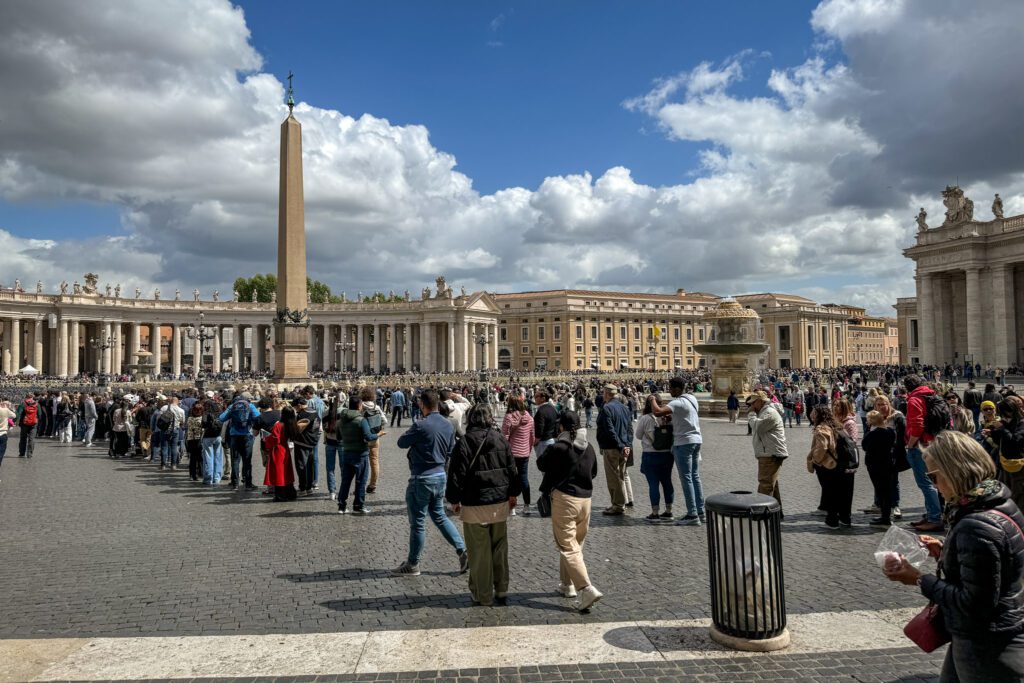
Combined with the skip-the-line entry, the first of the day, we think you’ll find that there’s not really a more efficient way to combine these two major sights in Rome.
The other scenario where the tour is absolutely worth it is if the tickets for the Vatican Museums are sold out for your dates, or if the early morning entry tickets are sold out for your dates.
One of the scenarios we hear most often is something along the lines of “Help! We’re visiting next week and tickets are sold out, what should we do?!”
In that scenario, your options are fairly limited, and a guided tour is basically the only option you have if you want to see the Vatican Museums.
A better, less common question is what to do if the only tickets available are for an entry time of something like 12pm.
The Vatican Museums are absolutely PACKED from 10am to 4pm (roughly), and the early entry tour will be a much less pleasant experience.
Putting my cards on the table here, given the choice between paying a premium for this tour and visiting on my own starting at 12pm, I’d do the tour ten times out of ten (especially considering the reasons we already covered above).
We think that a guided tour is a nice-to-have, but a self-guided tour armed with an audio guide (or, the Rick Steves audio guide app) is probably good enough.
Visiting the Vatican Museums Independently
If the tour isn’t in the budget (or you would prefer to go at your own pace), I have some thoughts about how to maximize your time when seeing the two main attractions at the Vatican.
First of all, you’ll need to buy entry tickets for the Vatican Museums, while St. Peter’s Basilica is free to enter.
For both, you’ll have to wait in the (sometimes long) security lines.
Normally, I would strongly recommend booking the audio guide if you want to visit independently to give you more context for what you’re seeing, but I actually thought the audio guide was fairly useless (we got them, and had basically ditched them by the second room).
Instead, I’d once again turn to the free Rick Steves audio guide (the easiest way to access is to download his app), which gives you a nice overview of each room and the key highlights as you meander through the museums.
Second of all, as I already mentioned above (but I think it’s worth mentioning again to reiterate), I would consider doing the Vatican Museums and St. Peter’s Basilica on different days.
The reason is that, by the time you’re done with the Vatican Museums and Sistine Chapel, it will be around noon (maybe even later, depending on your pace). Which means you’re going to be waiting in the security line
I would recommend, if you have the time, getting to St. Peter’s Basilica at opening (currently 7:00am) on a different day for a much more relaxing experience, and for the fact that the light will be better if you choose to climb the Dome (plus fewer people in the narrow passageways).
It is worth noting here that, if you do them on the same day, you will have to exit the Vatican Museums and wait in the (sometimes very long) security line for St. Peter’s Basilica because there is no cut through access (except for guided tours on certain days).
Opening Hours for the Vatican Museums
The Vatican Museums are open Monday to Saturday, 8:00am – 8:00pm (with final entry at 6:00pm). They are closed on Sunday, generally.
On the last Sunday of the month, entry for the Vatican Museums is free, and they are open from 9:00am – 2:00pm (with final entry at 12:30pm).
However, before you get too excited, it’s worth noting that the free entry days see the highest number of visitors, and it will be even busier than usual in the Museums (which is saying something).
Unless you’re on a REALLY tight budget, we’d actually recommend against visiting on the free days for a better experience (and tickets aren’t that expensive relative to other similar museums around Europe).
There are some random Mondays and Saturdays throughout the year that the Museums are closed, along with Christmas Day and New Year’s Eve.
They are actually open for limited hours on Christmas Eve and New Year’s Eve (8:00am – 3:00pm).
You can see a full calendar of the days that the Vatican Museums are open and closed in 2025 here.
Getting Tickets for the Vatican Museums
This is, perhaps, the most important part of this entire guide.
Tickets for the Vatican Museums are extremely competitive, and they absolutely will sell out – the only question is when (for peak season, it’s FAST, for November to March it’s a little less competitive).
At a high level, there are two ways to get tickets for the Vatican Museums: buy them online in advance, or buy them onsite on the day of your visit.
We STRONGLY recommend purchasing your tickets well in advance. They go on sale 60 days in advance, and sell out within an hour if it’s peak season. You’ll want to book them as soon as you are able to, and plan the rest of your Rome itinerary around that reservation.
Buying them in advance will give you access to the 8:00am and 8:30am entry slots.
The Vatican Museums are PACKED from roughly 10:00am to 4:00pm, which is when the vast majority of people visit.
Getting in there early will be a much more pleasant experience, especially for that first hour or two.
That’s not to say there will be nobody there at 9:00am, but the crowds are noticeably thinner (I noticed this on my last two visits, which were both at opening in the past two years).
If you don’t get those early entry spots, my guide for my last tour told me that a close second in terms of crowds is the couple of hours before closing.
Look at the 5:00pm and 5:30pm entry slots for that – the complex is open until 8:00pm, so you’ll have two and a half or three hours to cover everything (which is the right amount of time for most people, we think).
It is worth noting that there is a €5.00 service fee per ticket when you buy them online, which is essentially the price to skip the line at the ticket office.
Buy tickets for the Vatican Museums here – toggle the site to English with the language selector in the top right.
If you don’t get tickets online in advance, you can show up on the day of your visit and get tickets at the ticket office, pending availability.
However, it’s worth noting that the ticket office line often takes hours to get through (either you show up before they open and wait then, or you show up later and wait – either way there’s a wait!).
If tickets are sold out, the first thing I would do before booking a tour is look at online resellers, who generally have more availability than going direct (though not unlimited availability).
Here is the Get Your Guide page where you can check if they have availability for your date.
Tips for Visiting the Vatican Museums
Here are some tips for visiting the Vatican Museums that we’ve picked up over the course of our multiple trips.
Book your tickets in advance. We covered this already, but it’s worth reiterating because it’s that important. They go on sale 60 days in advance.
Book an early morning or late afternoon entry slot to avoid crowds. We also covered this, but if you hope to avoid the height of crowds you’ll want to book the early morning (8 or 8:30am) or late afternoon (5 or 5:30pm) entry slots.
For the late afternoon, remember that they close at 8:00pm, so your time will be slightly limited (though we think three hours is a good amount of time to spend inside the Vatican Museums).
Skip-the-line only allows you to skip one line, but there is a second line. If you buy them online, tickets include a fee that allows you to “skip the line.”
We’ve gotten (somewhat angry) notes from readers before who are frustrated that they still had to wait in a line, which is absolutely true.
There are two lines out front – the line for the ticket office (this is what you’re skipping) and the security line (this is what you and everyone else have to wait in) – and you get to skip the longer, slower line for the ticket office and head straight to the security line.
The free Rick Steves audio guide is better than the official paid version. I’m often a huge proponent of investing in the audio guide at art museums because it’s a good middle ground between a guided tour and just wandering around.
But when we used them on this latest trip, we had turned them off by the second room because it wasn’t engaging or telling a story – it was just recounting facts about the specific pieces of art, for the most part.
I’d turn instead to the free Rick Steves guide, which is pretty good (especially for the price of free – you need to download the app in advance so you can have offline access to the guide).
You’re not going to be able to see everything. This is truly a huge collection of art, and like the Louvre, you should absolutely not try to see every little piece.
My strategy when I’m not on a guided tour is to wander until something catches my eye, spend a bit of time there, and then move on.
I’m not stopping at literally every piece of art, otherwise you’d be here for days. I’d plan on spending three or four hours in the Vatican Museums because there is a lot to see.
There is no photo or video allowed inside the Sistine Chapel. Yes, there are guards. No, you shouldn’t try to sneak a photo. Be respectful!
It’s a lot of walking, including stairs. I clocked ~10,000 steps along the way, including several sets of stairs. If you have mobility restrictions, that might be a lot of moving around.
St. Peter’s Basilica
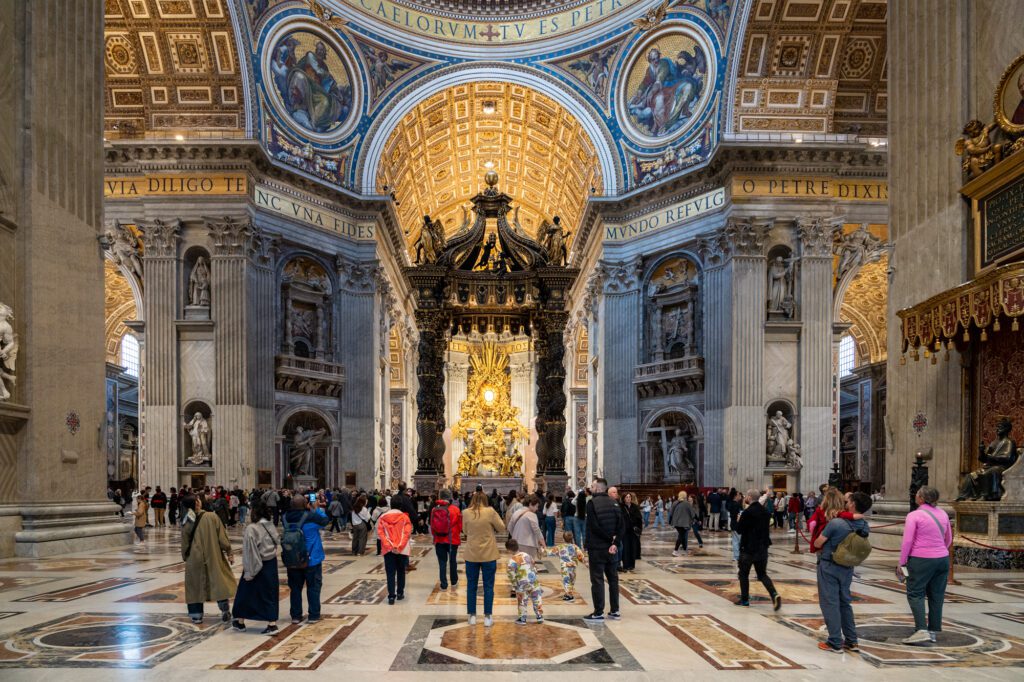
On my latest trip to Rome, I had a little bit of a revelation about the value of the Basilica di San Pietro and its incredible opulence.
Now, I’m not religious. I grew up going to church, read the Bible cover-to-cover, and nobody was able to answer any of my (very practical, I think) questions about the things I read, so here we are.
I had been to the basilica several times (three or four, I can’t remember which) before, and every single time my first thought is usually something along the lines of “think about how fast we could end world hunger if we sold off the pieces of this church.”
But as I was standing there admiring the altar, I realized that, though I’m not religious, the beauty of the basilica kind of made me want to be Catholic.
And that, my friends, is part of the reason why St. Peter’s Basilica was built; to project the immense wealth and power of the Catholic Church, which has played an important role in politics on the Italian peninsula and throughout Europe for more than 1,000 years at this point.
Divorcing the religion and politics from the art, the basilica is a masterpiece.
The current basilica was built over the course of the 16th and 17th Centuries on the site of an old Roman basilica (that was not nearly as grand as this version).
It’s the largest church in the world by interior area – a superlative that they have gone great lengths to preserve by making sure no other Catholic church surpasses it – which is in part thanks to the soaring ceilings.
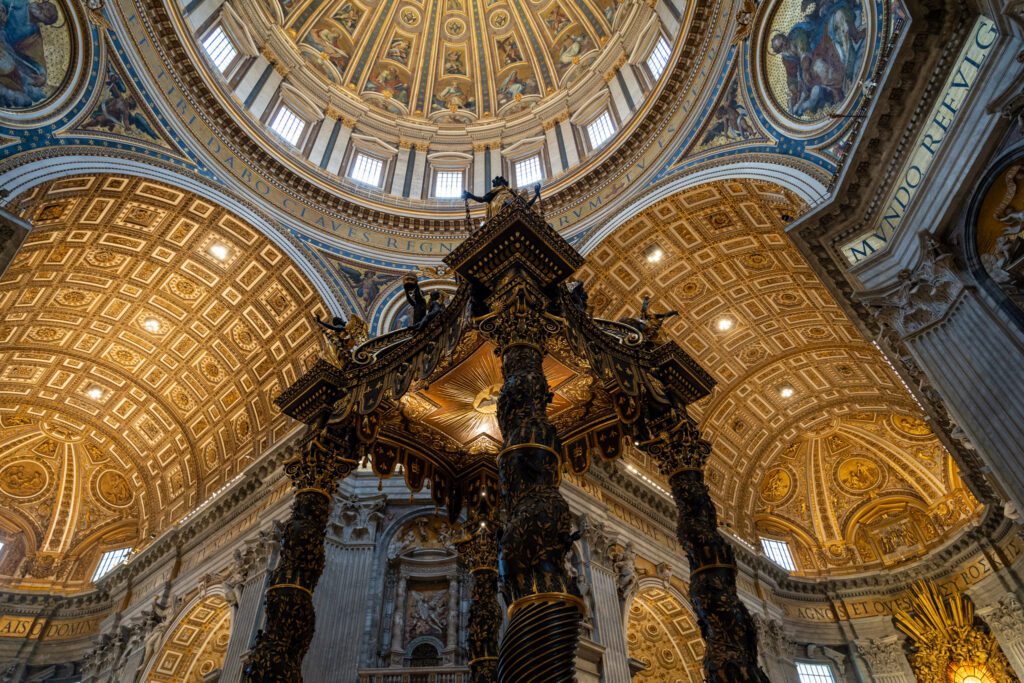
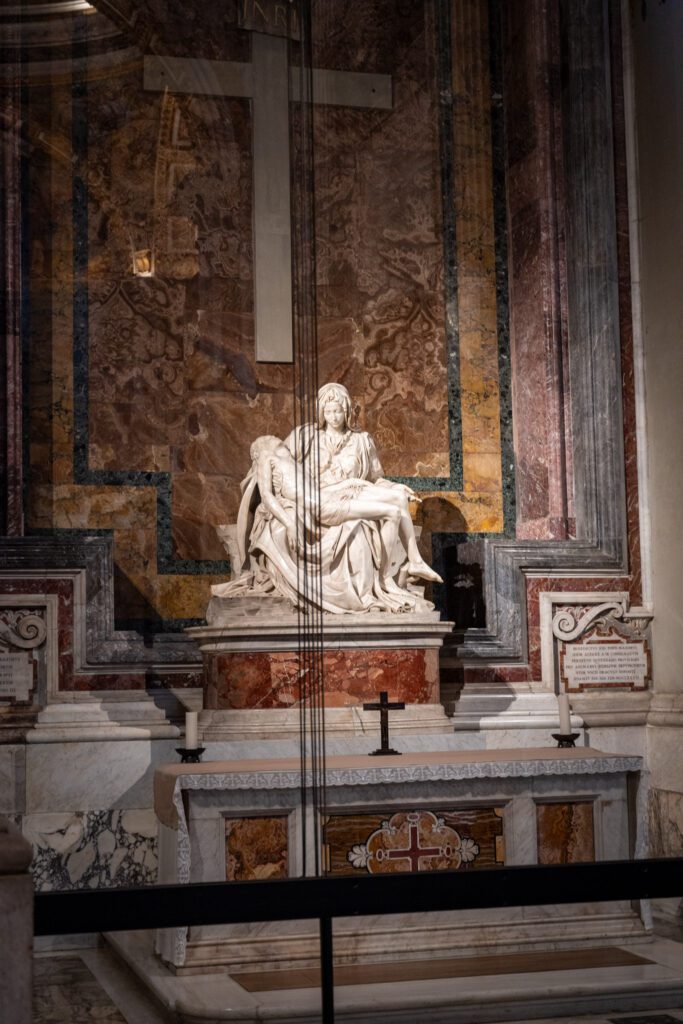
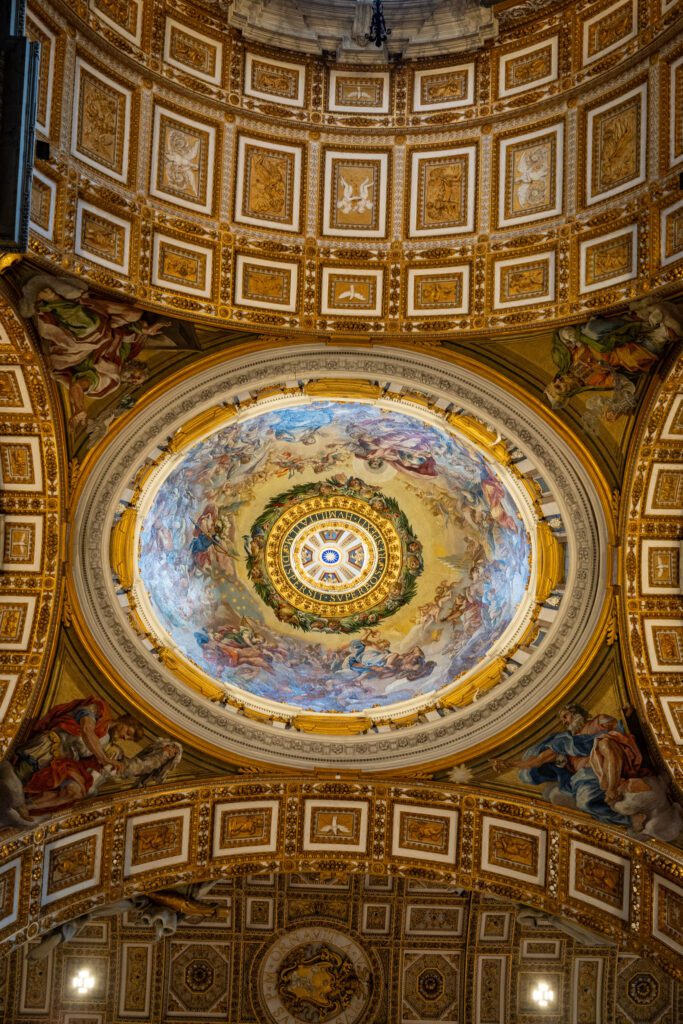
Should You Do a Tour of St. Peter’s Basilica?
While there are guided tours of St. Peter’s Basilica, we would save your time and money and prioritize a tour of the Colosseum, the Vatican Museums, and a food tour ahead of a tour of the Basilica.
Though it is worth noting that tours of the Vatican Museums include a (brief) tour of the Basilica, and usually end inside.
Visiting St. Peter’s Basilica Independently
Let’s talk about the practicalities of visiting St. Peter’s Basilica independently, like opening hours and how to enter (and your strategy for your visit to make the most of your precious time).
Opening Hours for St. Peter’s Basilica
The opening hours for the Basilica is constant throughout the year (at least at the time of writing), but the opening hours for climbing the Dome depend on the season, with longer hours in the busier summer season (where daylight lasts longer).
At the time of writing, the Basilica is open from 7:00am to 7:10pm.
During the high season (April through September), the Dome is open from 7:30am to 6:00pm.
During the lower period (October to March), the Dome is open from 7:30am to 5:00pm
You can see the most up-to-date information on opening hours on the official website here.
Do You Need Tickets for St. Peter’s Basilica?
Until recently (during Jubilee), it was completely free to enter the basilica (and every other basilica in Rome) and you did not even have the option to book in advance.
The good news is that it is still free to enter and you don’t need to book in advance, though you will have to wait in the (sometimes long) security lines, which tend to move pretty quickly.
The change is that they recently introduced an option where you can book in advance and pay €7 to, essentially, skip most of the security line, which you can book through the official website.
That security line can be long, but in my experience, it does move fairly quickly.
I’d only consider doing that if your visit is going to fall midday (and especially on a weekend) when the lines can take an hour or more.
We arrived at about 6:45am on a weekday in March to visit St. Peter’s Basilica and there was already a somewhat hefty line formed at the gates, which was mostly made up of big groups.
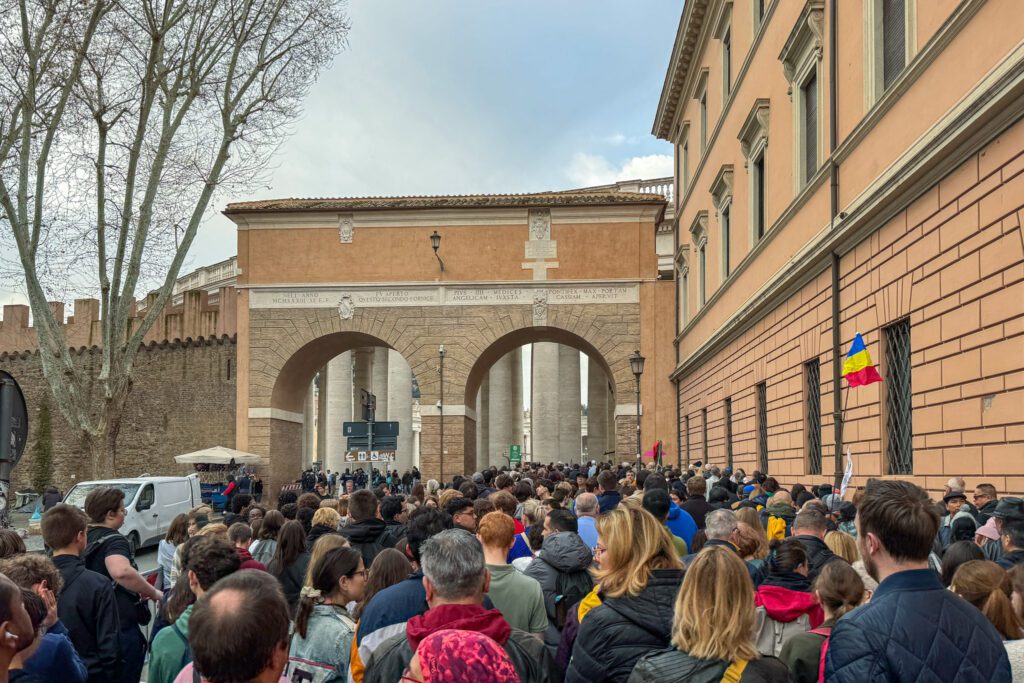
Still, it moved quickly and we were inside the basilica by 7:20am or so.
Climbing the Dome at St. Peter’s Basilica
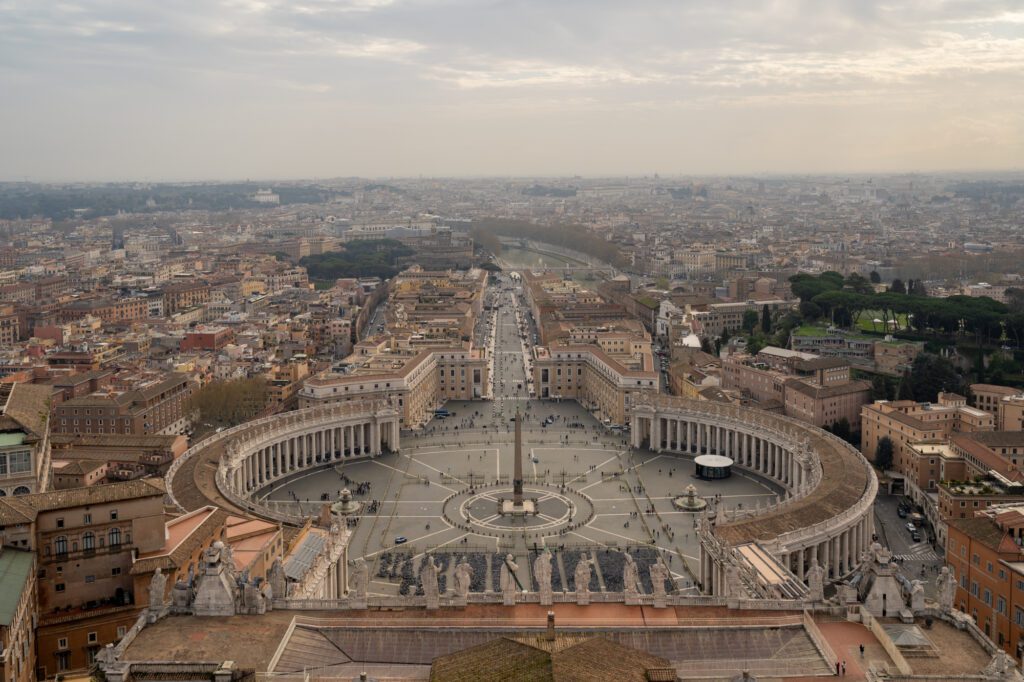
On my latest trip to Rome, one of the few things I wanted to do that was new to me after a bunch of trips to Rome over the past decade or so (I think I’m at six?) was to climb the Dome of St. Peter’s Basilica.
Prior to that visit, I had been to St. Peter’s Basilica several times, but I had never embarked on the 500+ step climb up to the top of the tallest dome in the city.
One of the aspects of the climb that I enjoyed most is the short walkway that takes you along the interior of the dome, giving you a nice view of the frescoes from up close.
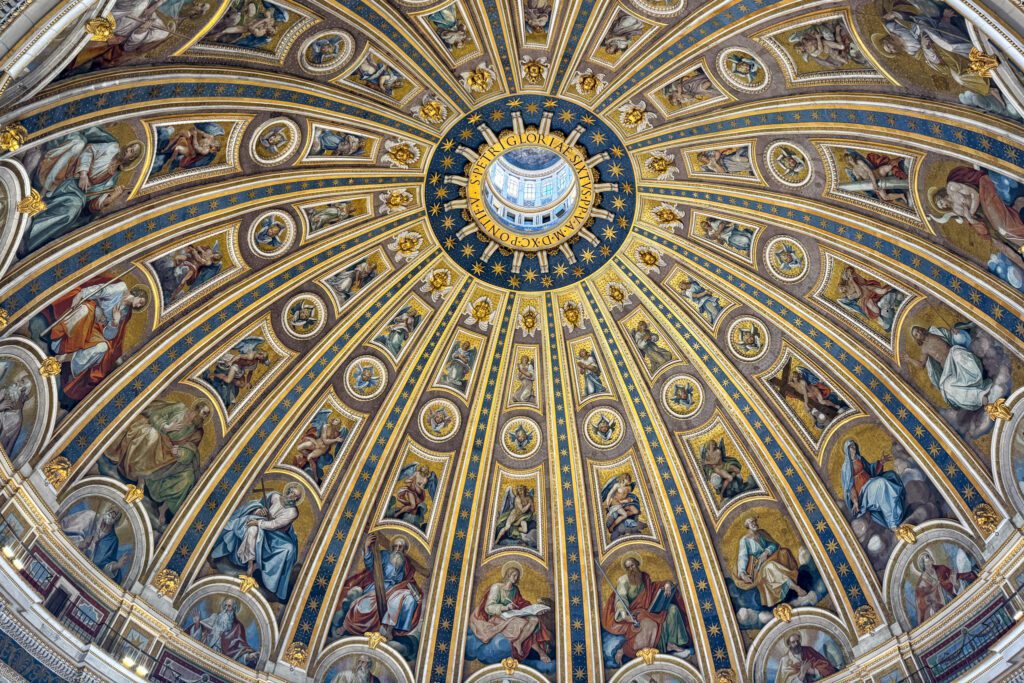
If you are claustrophobic or afraid of heights, I would say that there are a couple of points – a narrow staircase and passageway and the climb along the interior of the dome – that will be a bit troublesome.
Generally speaking, the passageways to get to the domes of these churches were not necessarily built with the idea of hundreds of tourists an hour using them, so they can be a little cramped.
There is an option to skip about 200 of the stairs by using an elevator, which costs an extra couple of Euros per person.
You still have to do a majority of the climbing, so it doesn’t necessarily work if you’re unable to climb any stairs, but it does get you to the path along the inside of the dome.
From the top, you have a 360-degree view of the surrounding area, including some fabulous views of the city and Piazza San Pietro from above, and of the Vatican’s gardens.
It costs €8 (taking the elevator instead of the stairs is another €2, but you should know that you’re only cutting out about half of the stairs on the climb) and you’ll have to wait in another line within the complex to access it.
While you technically can now book in advance, it’s not worth booking in advance because it’s twice the price and includes skipping the line and the audio guide, which you don’t need (especially if you’re here when they open).
To skip the lines for the ticket office of the dome and have a better experience, we’d actually head there first right at the opening of the basilica so that you get to be one of the first groups up, then come back down and visit the rest of the church (where you will not have to deal with a line, and there’s plenty of space for everyone).
Tips for Visiting St. Peter’s Basilica
Here are some tips for visiting St. Peter’s Basilica.
You must cover your knees and shoulders inside St. Peter’s Basilica. It’s a Catholic church after all, so leave the short shorts and tank tops at home for this day, otherwise they will not allow you to enter.
If it’s really hot and you want to wear a tank top, bring something to cover your shoulders when you enter the Basilica.
Save time by arriving at opening and heading straight to the Dome first.
The most efficient way to do things here is to arrive at opening, head to the ticket office for the Dome, and head to the top when it opens. Then, once you’re done, come back down and explore the rest of the Basilica.
For more context, use the free Rick Steves Audio guide. We’ve been using the free Rick Steves guides for years, and they’re pretty good (especially for the price of free – you need to download the app in advance so you can have offline access to the guide).
Other Things to See Near the Vatican
Here are some things to see near the Vatican while you’re in the area.
Castel Sant’Angelo: Originally built by Roman Emperor Hadrian as a mausoleum and eventually used by the Pope to hide out from barbarian invasions (and other European powers invading) Rome, the best part of Castel Sant’Angelo is the view of the dome of St. Peter’s Basilica from the rooftop terrace.

Walk up to Piazza Garibaldi: One of our favorite things to do in Rome is to climb the hill that rises above the south bank of the Tiber behind Trastevere up to Piazza Garibaldi, which has one of the best views out over Rome from above (plus some interesting history around the unification of Italy).
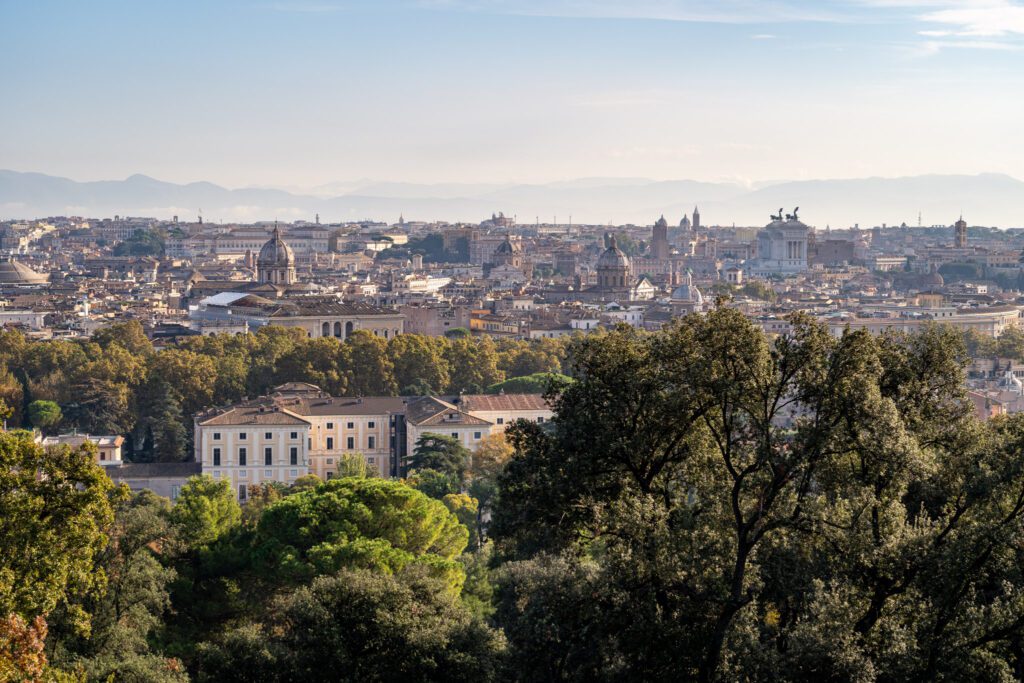
Here’s a map of the rough route we took, with the stops we’d recommend making along the way from the Vatican and back down into Trastevere.
This is best on a clear day when you can see across the city to all of the rooftops and domes around the city.
LOVE and Pergamino: Two of my favorite specialty coffee shops in Rome are just a few blocks away from each other.
Pergamino is the OG of specialty coffee in Rome, and they have literally been on that corner across from the Vatican for a decade now (the location means that the service can be a little bit gruff, but the coffee is great).
LOVE is relatively new, but I’ve been there over multiple trips and not only is the coffee amazing, but their handmade pastries are also top notch (source: dragged my mom and uncle here to get their take because I have Celiac Disease, so no gluten for me).
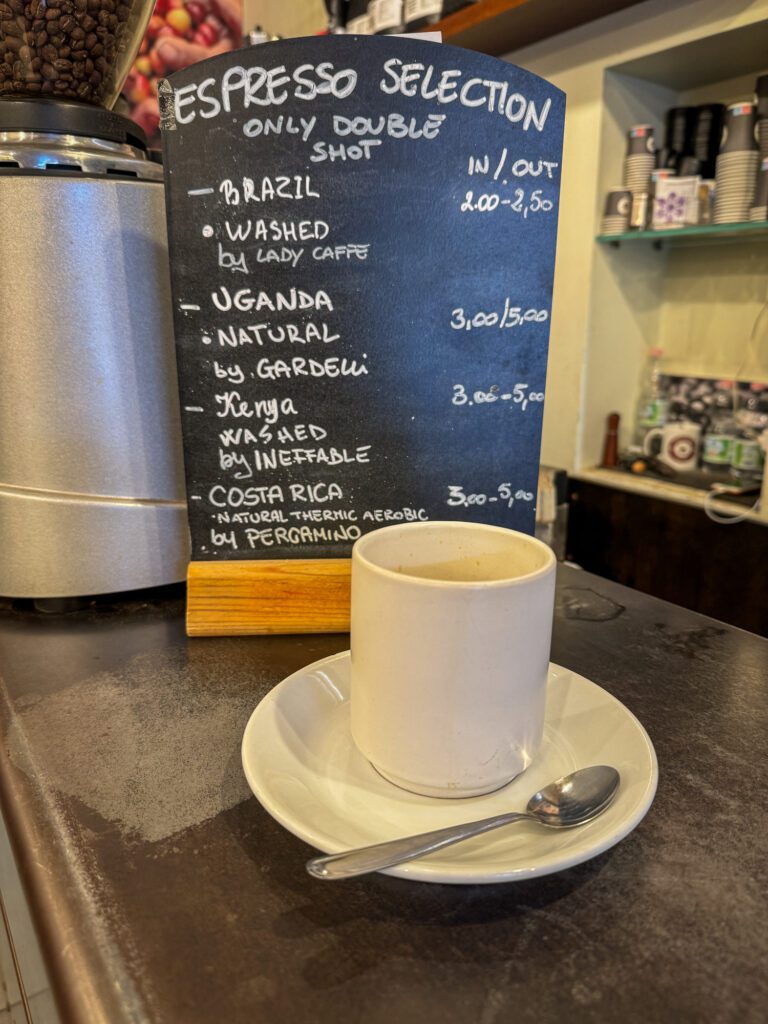

Bonci Pizzarium: The most famous pizza al taglio in Rome (the chef was featured on all sorts of Netflix Shows like Chef’s Table), this has also been in this location for a decade.
I know because I read about it before my trip with friends in 2014 that I referenced above and dragged them here. It was chaotic (none of us knew a word of Italian and it was busy and Italians aren’t known for being great at making orderly lines) and delicious.
You pay by weight, so get a few different flavors to split with your companions. Worth noting that, with their fame, it’s now very busy and you can likely find similar quality with a much lower wait time elsewhere.
El Maíz: On one of our last days of a six week stint in Italy, we were a little burnt out on Italian food. Searching for something new (and gluten free), I stumbled upon this Venezuelan gem that makes arepas, one of our favorite food groups, and I’ve been here on every trip to Rome since. They’re really good, and it’s an excellent value too.
Planning a trip to Italy? We’d love to help!
Here are our other Italy travel guides to help you plan an incredible trip (even if you have to eat gluten free!).
If there’s no link below, it means we’re still working on it – long, in-depth guides take time! We’re working on it, though, we promise.
If you’re planning a trip and you’re not sure where to start, your first stop should probably be one of our detailed itineraries.
We have a two week Italy itinerary that blends the main cities with some less-visited cities that we love (BOLOGNA!), a guide to spending 10 days in Italy that focuses mostly on the highlights, and a whirlwind guide to spending one week in Italy that features the Rome – Florence – Venice highlight circuit.
We also have a guide covering important tips for traveling to Italy for the first time, which is a collection of things we’ve learned over the course of our time in Italy that will help you have a smoother, more immersive trip.
Here are more specific guides to the main cities in Italy.
Rome
- What to do in Rome (as a First Timer)
- How to Plan an Amazing 4 Day Rome Itinerary
- Where to Stay in Rome: A Complete Guide for First Timers
- 26 Things to Know Before You Visit Rome
- Gluten Free Rome: A Complete Guide to GF Restaurants + Bakeries
- Where to Find the Best Specialty Coffee in Rome
Florence
- What to do in Florence (as a First Timer)
- How to Plan an Amazing Florence Itinerary (3 Days)
- Where to Stay in Florence: A Complete Guide for First Timers
- Gluten Free Florence: A Complete Guide to GF Restaurants + Bakeries
- Where to Find the Best Specialty Coffee in Florence (for Coffee Nerds)
- The Best Day Trips from Florence (Complete Planning Guide)
Venice
- A Perfect 3 Day Venice Itinerary (for First Timers)
- Exactly What to Do in Venice (As a First Timer)
- Where to Stay in Venice: A Complete Guide
- Gluten Free Venice: A Complete Guide (for Foodies)
Bologna
- What to do in Bologna (as a First Timer)
- How to Spend One Incredible Day in Bologna
- How to Plan an Amazing Bologna Itinerary (2 Days)
- Where to Stay in Bologna: A Complete Guide for First Timers
Cinque Terre
- What to do in Cinque Terre (as a First Timer)
- How to Plan an Amazing Cinque Terre Itinerary (2 Days)
- Where to Stay in Cinque Terre: A Complete Guide for First Timers
Milan
- What to do in Milan (as a First Timer)
- How to Plan an Amazing Milan Itinerary (2 Days)
- Where to Stay in Milan: A Complete Guide for First Timers
- Gluten Free Milan: A Complete Guide to GF Restaurants + Bakeries
The Rest of Italy
